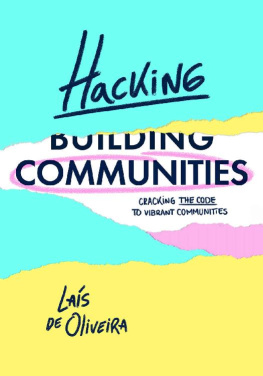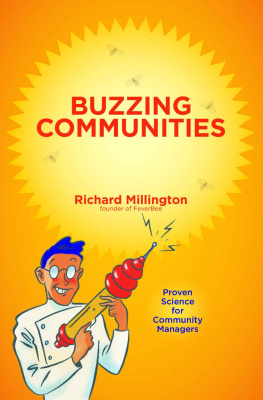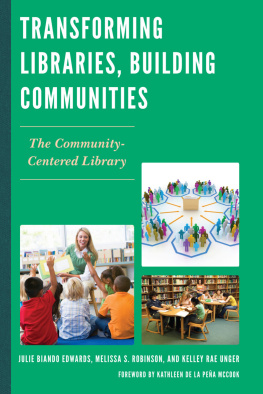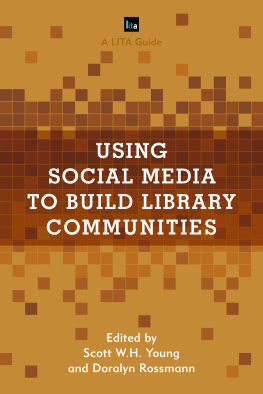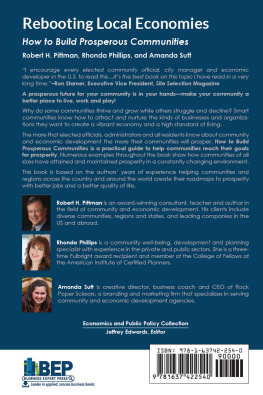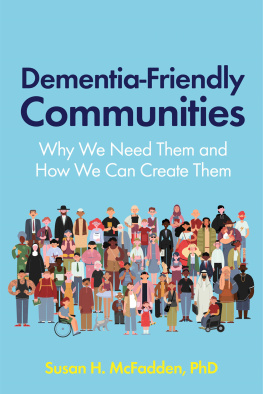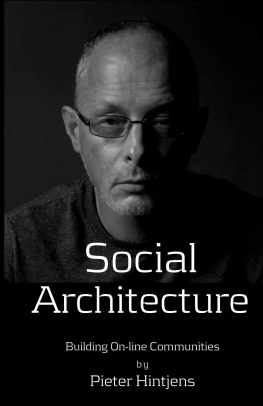Contents
PART I
PART II
For my late grandmother.
Foreword
In the early days of building Startup Grind, we interacted with thousands of people around the world: from speakers, to attendees, to community leaders. I personally got on video calls with hundreds of people who wanted to be involved. The main criteria for access to Startup Grind was always a very simple question: does this person share our values? If they did, then we would do anything to get them involved in building with us. If they didnt, then we ran from them as quickly as possible.
Startup Grinds values are simply to give before you take, help others first, and make friends. Few people I have met exemplify those values better than Las de Oliveira. I first met Las as she was building the Startup Grind chapter in Buenos Aires in 2012. There, she brought startups and founders together to learn and meet. It quickly became one of our most important groups in Argentina and for our community globally.
We asked Las to take what she had learned and teach others by joining us full time. In this role, she helped lead expansion from a few dozen cities to hundreds in a few short years. I remember brainstorming with the team one time and she said, We must figure out how to get Startup Grind in five hundred cities. I burst out laughing. Such an idea was crazy. Were there even five hundred cities big enough for Startup Grind? Could we find enough people who would be interested? But this is the vision and drive of Las. Today, we have six hundred active chapters hosting fifteen thousand events in over a thousand cities.
I watched in amazement as Las traveled to Kuala Lumpur and started building yet another community. As a startup founder and the Startup Grind leader for Malaysia, she was equally successful as before. When I visited her chapter in 2016, I was amazed to see hundreds of people following her yet again. Not long after, she moved to San Francisco, where she again started building and leaving a mark. Then, the next time I saw Las was in Spain, where she was building yet again.
Some people are driven by what they feel is right versus what they are expected to do. Las is one of those rare people who lead their life by how they think the world should be, and in ways that can help the most people possible around them. This is what makes her the best type of community builder. She is someone who can find common ground with anyone in the world and strive to help bring meaning to them. Thats why in almost every continent in the world, she has managed to build community and why her insights on community building are as important as anyone you can learn from on this topic.
Derek Andersen
Co-founder / CEO
Startup Grind / Bevy
December 2020
Introduction
Why Building Communities is Like Coming Home
It is good to have an end to journey toward; but it is the journey that matters, in the end.
Ernest Hemingway
Community Building: Home
Our individual experiences of home may differ, but most of us can relate to an idealistic idea of home. Home is where your heart is. Home is not a place, but a feeling. Theres no place like home.
Home isnt a place, but a symbol. From ancient times, we have cultivated the idea of home as the original place where we feel safe. Our first home is our mothers womb, and our departure from it is our first interaction with pain. This concept is explored in The Book of Symbols by the Archive for Research in Archetypal Symbolism, which states:
A house is one embodiment of home; home is where the heart is, a feeling state of belonging, safety, and contentment. Physically, our earliest home is the maternal womb in which we are gestated, and like the animals who instinctively make their homes in nests, burrows in the earth, the hollows of trees, caves and clefts, many of the first homes of our devising were intimate, encompassing womb like structures. All over the world, cave drawings attest to our primordial presence. Mud huts in parts of Africa are still fashioned in the form of the female torso, with vaginalike slits as doors To be unhoused is not necessarily to be homeless. On woods, desert, the moon, a ship at the sea, a beloved friend, a particular city, a set of circumstances, is projected home. These correspond to, or contribute to something within, the experience of a vital center of both fixity and freedom, rest after striving, being fully oneself.
In essence, home is the dream of a place where we are safe. The same book describes home as the goal of epic odysseys, spiritual quests, and psychic transformations. Home is an internal state of mind that we crave. To find this idealistic place, we often have to leave our existing place of comfort in search of something that might lead us to a lifelong journey.
We aim to find a place where we belong. That dream of belonging is a dream of home itselfa dream of a place where we are accepted as we are,as our most authentic selves. We crave this place for reasons larger than uswe are wired to belong as a means to survive, which we will explore in Chapter 5.
The concept of home is a key part of building a community. In a nutshell, the path of a community builder is that of someone building a home and welcoming others in to share, own, and help expand it.
Do You Feel at Home Today?
The world has changed tremendously in recent centuries and exponentially in the last 20 years.
Today, were mobile and connected. Technology has transformed how we interact and expanded our boundaries. Weve moved from being defined by our geography or culture to having the freedom to belong anywhere. Access to information has enabled us to find each other online and meet offline. In the 21st century, we are free to belong anywhere and to express ourselves in groundbreaking and authentic ways that were unimaginable in the past. We are free to belong beyond location, nationality, gender, sexual orientation, or ethnicity. The opportunity to build more diverse communities is unprecedented.
Yet, we are the loneliest generation ever. Loneliness is a modern epidemic and it impacts our health in a myriad of ways. Well explore this topic more in Chapter 4, but for now, Id like us to consider the idea that if we are allowed to redesign belonging, we must take it. For our own good and for that of our peers and loved ones.
Hacking communities is about building safer spaces for us and others to feel at home in a world threatened by loneliness.
As a community builder, your role is to make others feel at home. This means creating a space where they feel safe to take off their shoes, and where they can be vulnerable and express themselves authentically. Home is where we find true belonging.
To create this space, your first step is to feel at home with yourself. You must be the first to take the courageous step to be vulnerable and express yourself authentically. To do so, you must practice loving yourself first. But this doesnt mean you have to wait until you are fully ready and prepared to build a communitytrue belonging is not a destination, but a lifelong journey. It is the way home, like Dorothys journey through the cyclone, Alices down the rabbit hole and Bilbos there and back again.

